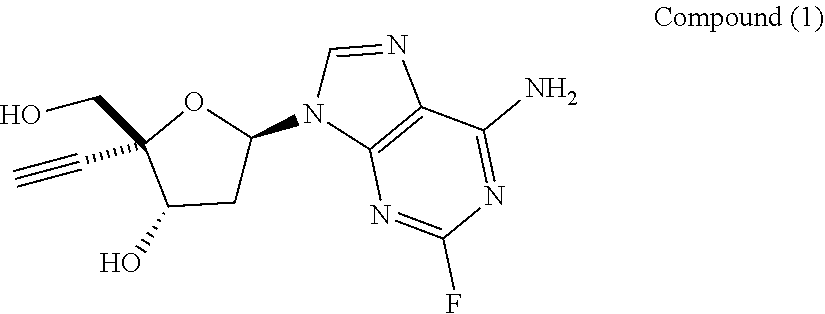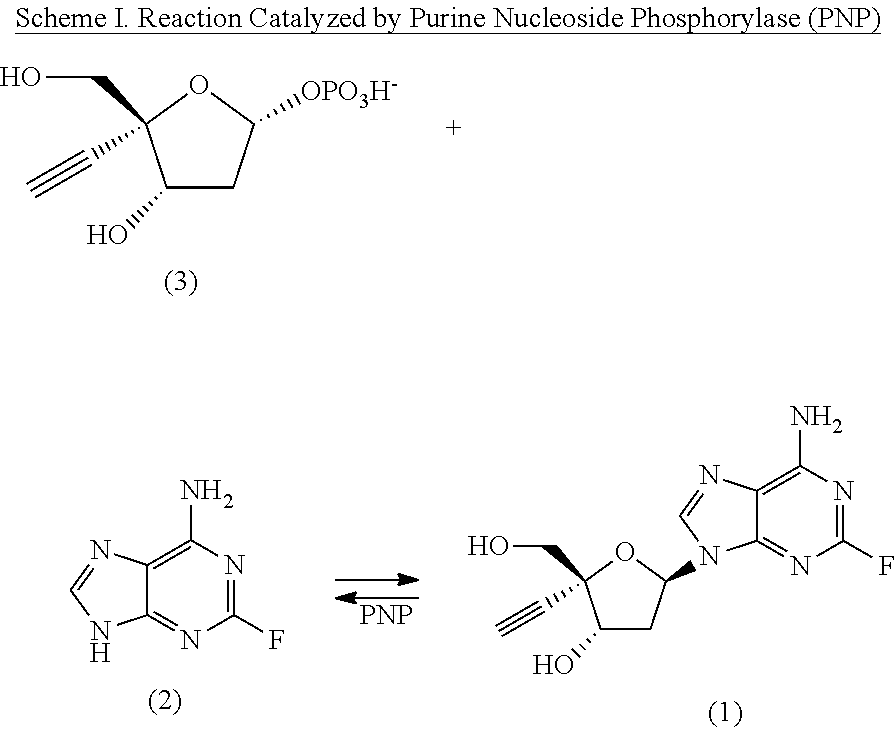Engineered purine nucleoside phosphorylase variant enzymes
a technology of nucleoside phosphorylase and variant enzymes, which is applied in the field of engineered purine nucleoside phosphorylase (pnp) enzymes, polypeptides, can solve the problems of dna reactivation delay and the challenge of nucleoside analogue production by standard chemical synthetic techniques, and achieve the effect of improving activity on a substra
- Summary
- Abstract
- Description
- Claims
- Application Information
AI Technical Summary
Benefits of technology
Problems solved by technology
Method used
Image
Examples
example 1
Preparation of HTP PNP Containing Wet Cell Pellets
[0190]The parent gene for the PNP (SEQ ID NO: 2) enzyme used to produce the variants of the present invention was obtained from the E. coli genome and cloned into a pCK110900 vector. W3110 E. coli cells were transformed with the respective plasmid containing the PNP encoding gene and plated on LB agar plates containing 1% glucose and 30 μg / ml chloramphenicol (CAM), and grown overnight at 37° C. Monoclonal colonies were picked and inoculated into 180 μl ALB containing 1% glucose and 30 μg / mL chloramphenicol and placed in the wells of 96-well shallow-well microtiter plates. The plates were sealed with O2-permeable seals and cultures were grown overnight at 30° C., 200 rpm and 85% humidity. Then, 10 μl of each of the cell cultures were transferred into the wells of 96-well deep-well plates containing 390 μl TB and 30 μg / mL CAM. The deep-well plates were sealed with O2-permeable seals and incubated at 30° C., 250 rpm and 85% humidity unt...
example 2
Preparation of HTP PNP-Containing Cell Lysates
[0191]Frozen pellets prepared as described in Example 1 were lysed with 200 μl lysis buffer containing 100 mM triethanolamine buffer, pH 7.5, 1 mg / mL lysozyme, 0.5 mg / mL PMBS and 5 mM MnCl2. The lysis mixture was shaken at room temperature for 2 hours. The plate was then centrifuged for 15 min at 4000 rpm and 4° C. The supernatants were then used in biocatalytic reactions as clarified lysate to determine the activity levels.
example 3
Preparation of Lyophilized Lysates from Shake Flask (SF) Cultures
[0192]A single colony containing the desired gene picked from an LB agar plates with 1% glucose and 30 μg / ml CAM, and incubated overnight at 37° C. was transferred to 6 ml of LB with 1% glucose and 30 μg / m1 CAM. The culture was grown for 18 h at 30° C., 250 rpm, and subcultured approximately 1:50 into 250 ml of TB containing 30 μg / m1 CAM, to a final OD600 of about 0.05. The subculture was grown for approximately 195 minutes at 30° C., 250 rpm, to an OD600 between 0.6-0.8, and induced with 1 mM IPTG. The subculture was then grown for 20 h at 30° C., 250 rpm. The subculture was centrifuged at 4000 rpm for 20 min. The supernatant was discarded, and the pellet was resuspended in 35 ml of 25 mM triethanolamine buffer, pH 7.5, with 5 mM MnCl2. The cells were lysed using a Microfluidizer® processor system (Microfluidics) at 18,000 psi. The lysate was pelleted (10,000 rpm×60 min), and the supernatant was frozen and lyophilized...
PUM
| Property | Measurement | Unit |
|---|---|---|
| pKa | aaaaa | aaaaa |
| temperature Tm | aaaaa | aaaaa |
| temperatures | aaaaa | aaaaa |
Abstract
Description
Claims
Application Information
 Login to View More
Login to View More - R&D
- Intellectual Property
- Life Sciences
- Materials
- Tech Scout
- Unparalleled Data Quality
- Higher Quality Content
- 60% Fewer Hallucinations
Browse by: Latest US Patents, China's latest patents, Technical Efficacy Thesaurus, Application Domain, Technology Topic, Popular Technical Reports.
© 2025 PatSnap. All rights reserved.Legal|Privacy policy|Modern Slavery Act Transparency Statement|Sitemap|About US| Contact US: help@patsnap.com



